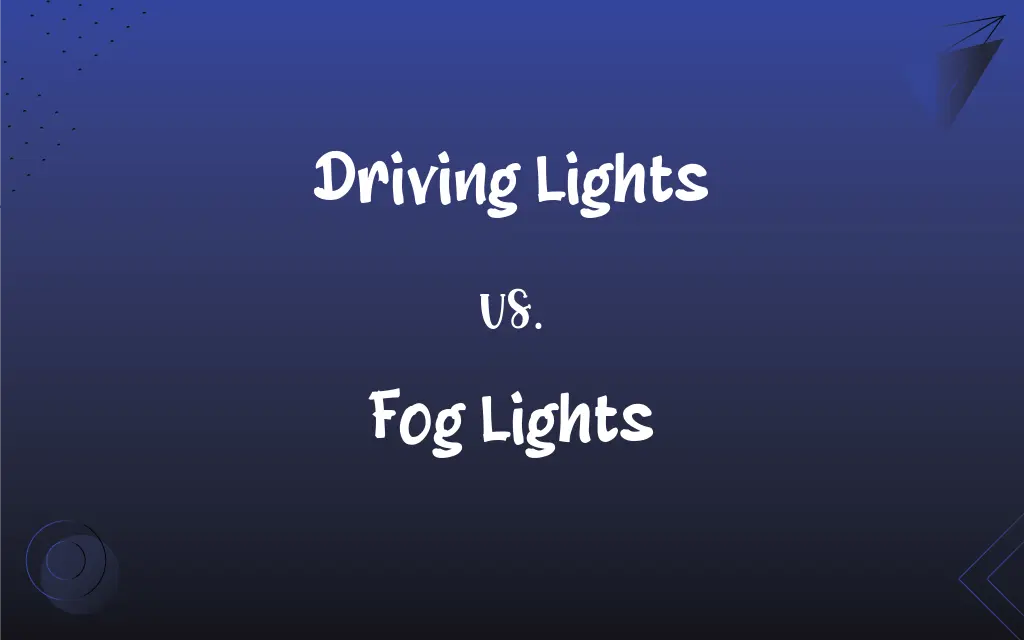Driving Lights vs. Fog Lights: What's the Difference?
Edited by Janet White || By Harlon Moss || Updated on October 10, 2023
Driving lights illuminate the road for general driving; fog lights focus on the road surface in poor visibility.

Key Differences
they function as automotive lighting devices but have distinct purposes and designs. Driving lights primarily aim to illuminate the road over long distances, enhancing visibility during normal and particularly dark driving conditions. Conversely, fog lights focus on improving road visibility during inclement weather conditions, such as fog, rain, or snow.
driving lights serve as necessary tools to brighten the path significantly farther than the standard headlights, aiding the driver in navigating through dark terrains. Fog lights, conversely, aren’t always imperative but serve to cut through adverse weather, offering a clear view of the immediate road surface and assisting drivers in safely traversing through harsh conditions.
the specific design of driving lights involves a longer, more focused beam to extend visibility far down the road or trail. On the other hand, fog lights are crafted with a wide, short beam, directing light downward to prevent light scatter and reflection back into the driver’s eyes, which is crucial for navigating through dense fog or heavy precipitation.
it's pivotal to understand when to employ driving lights and fog lights effectively and legally. While driving lights are generally utilized during nighttime driving on dark roads, they should be dimmed for oncoming traffic to avoid blinding other drivers. Fog lights, while essential during foggy conditions, should be switched off when visibility improves to avoid unnecessary light pollution and potential distraction to other road users.
driving lights are typically positioned higher on the vehicle to project a far-reaching beam, often being mounted on the grille or roof of off-road vehicles. In contrast, fog lights are installed lower on the vehicle, usually integrated into the front bumper, to ensure that the light is directed just above the road surface and under the fog to illuminate the road without bouncing back into the driver’s field of vision.
ADVERTISEMENT
Comparison Chart
Primary Purpose
Enhance general night visibility
Improve visibility in poor weather
Beam Type
Long and focused
Short and wide
Usage Conditions
Dark roads and trails
Fog, rain, and snow
Position on Vehicle
Higher, can be on grille or roof
Lower, often in the front bumper
Legal Regulations
Often need to be dimmed for oncoming traffic
Should be used only in specified poor visibility conditions
ADVERTISEMENT
Driving Lights and Fog Lights Definitions
Driving Lights
In off-roading, driving lights serve to significantly brighten the path, ensuring safe navigation through uneven, shadowy terrains.
Her truck’s robust driving lights illuminated the rocky path ahead, making nocturnal off-roading possible and safer.
Fog Lights
Fog lights are specialized automotive lights designed to improve road visibility during foggy or misty conditions.
During the thick winter fog, Maria switched on her fog lights to navigate safely through the obscured road.
Driving Lights
Some driving lights are designed with specific technologies, like LED or Halogen, each offering varying light intensities and hues.
The LED driving lights on his Jeep cast a bright, white light, starkly illuminating the forest path ahead.
Fog Lights
Unlike regular headlights, fog lights aim to illuminate the road immediately ahead of the vehicle, reducing glare and bounce-back off the fog or precipitation.
Even amidst the swirling snow, the fog lights offered clear visibility of the snowy path just in front of his car.
Driving Lights
Driving lights are often available in various shapes and sizes, catering to diverse vehicle models and lighting requirements.
She installed compact, round driving lights on her motorcycle, ensuring that she had ample light on her nightly rides.
Fog Lights
While fog lights are crucial during certain weather conditions, it is legally required in many regions to use them judiciously, only during specified poor visibility situations.
He ensured to turn off his fog lights once the mist cleared, adhering to local driving regulations.
Driving Lights
Driving lights are designed to supplement high-beam headlights for enhanced road illumination during nighttime.
On the remote, dark trail, his vehicle’s driving lights were crucial in navigating through the rugged terrain.
Fog Lights
They are generally installed lower on a vehicle and produce a wide, bar-shaped beam of light that illuminates the road surface without reflecting off the water droplets in the air.
His fog lights, casting a low, wide beam, revealed the slick, rain-drenched road, aiding him during the storm.
Driving Lights
Driving lights can also function as stylistic and functional additions to vehicles, providing both aesthetic and practical value.
The classic car looked even more striking with chrome-trimmed driving lights mounted on its front grille.
Fog Lights
Fog lights are available in various colors, with yellow and white being the most common, to effectively penetrate through adverse weather conditions.
Her yellow fog lights, casting a warm glow, allowed her to see the road markings through the dense fog.
FAQs
What is the primary purpose of driving lights?
To enhance road visibility over long distances during nighttime and dark driving conditions.
Are fog lights and driving lights interchangeable?
No, they serve different purposes and have different designs to suit specific visibility conditions.
Do all vehicles come with both driving lights and fog lights?
No, the inclusion of these lights varies by model, make, and vehicle type.
Are LED driving lights better than halogen?
LED lights often provide brighter, clearer light and are more energy-efficient but can be pricier than halogen.
Should I use driving lights during daytime?
Typically no, driving lights are meant for dark conditions unless visibility is hindered during the day.
Are fog lights always installed at the front of the vehicle?
Primarily yes, to illuminate the road ahead, though some vehicles also have rear fog lights to enhance visibility from behind.
Is it illegal to use fog lights when it's not foggy?
In many regions, yes – fog lights should only be used in specific low-visibility conditions.
Can using driving lights drain my vehicle's battery?
If used appropriately and in good working order, they should not unduly drain the battery.
What is the beam pattern like for fog lights?
It is typically wide and short, focusing light directly on the road surface.
Are fog lights only useful for foggy conditions?
Primarily yes, but they can also aid in other low-visibility conditions like heavy rain or snow.
Should I turn off driving lights when other vehicles approach?
Yes, to prevent blinding oncoming drivers with the intense beam.
When are fog lights especially beneficial?
During adverse weather conditions like fog, rain, and snow, where visibility is significantly reduced.
Can I use fog lights as driving lights?
It's not recommended due to their different beam shapes and intended use cases.
Do fog lights help in heavy rainfall?
Yes, they can help illuminate the road surface and improve visibility.
Can I replace my fog lights with a different color?
Yes, but always check local regulations to ensure your chosen color is legal.
Can driving lights be used in the city?
It depends on local regulations, but generally, driving lights should be dimmed or turned off in well-lit areas and for oncoming traffic to prevent glare.
How are driving lights powered?
They are powered by the vehicle’s electrical system and are controlled via a switch inside the vehicle.
Can I install additional driving lights on my vehicle?
Yes, but ensure to comply with local regulations regarding placement and usage.
What colors are fog lights typically available in?
Commonly, they are available in white and yellow.
Can I adjust the angle of my driving lights?
Yes, most driving lights allow for adjustment to ensure optimal illumination and to prevent dazzling other drivers.
About Author
Written by
Harlon MossHarlon is a seasoned quality moderator and accomplished content writer for Difference Wiki. An alumnus of the prestigious University of California, he earned his degree in Computer Science. Leveraging his academic background, Harlon brings a meticulous and informed perspective to his work, ensuring content accuracy and excellence.
Edited by
Janet WhiteJanet White has been an esteemed writer and blogger for Difference Wiki. Holding a Master's degree in Science and Medical Journalism from the prestigious Boston University, she has consistently demonstrated her expertise and passion for her field. When she's not immersed in her work, Janet relishes her time exercising, delving into a good book, and cherishing moments with friends and family.































































